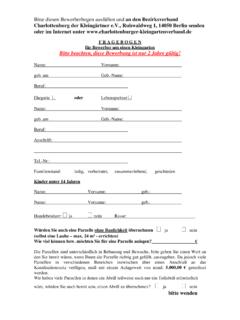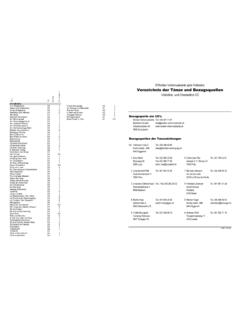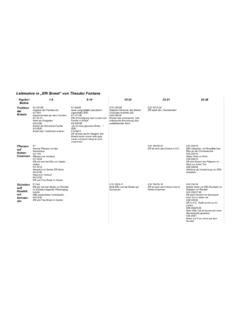Transcription of Spitsbergen - Blue Planet Sail
1 Spitsbergen Triplog - Reisetagebuch 11 22 September 2010 SV Antigua The SV Antigua was built in 1957 in Thorne (UK) and served for many years as a fishing vessels, until it was completely re-built in the early 1990s in the Netherlands as a barkentine and equipped as a passenger ship. A barkentine has three masts with square sails on the foremast. Die Antigua wurde 1957 in Thorne (UK) gebaut und fuhr ber viele Jahre hinweg als Fischereischiff, bis sie in den fr hen 1990ern in den Niederlanden von Segelschiff-Liebhabern als Barkentine von Grund auf berholt und f r die Passagierfahrt fit gemacht und ausger stet wurde.
2 Eine Barkentine (oder Schonerbark) zeichnet sich durch drei Masten mit bestimmten Formen der Takelung aus: 4 Rahsegel am Vormast, 2 Gaffelsegel und Staksegel. 2 With / Mit Captain / Kapit n Joachim Schiel First mate / Erster Steuermann Alexander Ali Schmidt Second mate / Zweiter Steuermann Ismael Ramonde Deckhand & chief entertainment officer / Matrose Thomas Gall Chef / K chin Trisha Prinzmeier Service Kathrin V lker Service Hanna Bohn Expedition leader / Fahrtleiter Rolf Stange Guide Michelle van Dijk 11 September: Longyearbyen, Pyramiden Position at noon: 78 14' N 15 36' E.
3 Temperature: 1,5 C foggy At noon everyone was onboard so we could leave foggy Adventfjorden towards Billefjorden where there weather is often better. We could not see much of the landscape, the fog created a serene atmosphere. There was no wind and Fulmars used the turbulence of the ship to fly. We could see their reflections in the water and a frozen rainbow in front of the ship. Captain Joachim gave us a board-safety briefing, telling us that we are not allowed to fall overboard or make bonfires on the ship. Al little later, after Trisha's cake, our guides Rolf & Michelle gave us a briefing about important things on land.
4 When we entered Billefjorden, the sky cleared up and mountains appeared. One is in the shape of a pyramid, and that was where we were heading. At the foot of the mountain lays the Russian settlement Pyramiden. A coal mining settlement that was abandoned in 1998. The coal here comes from the Carboniferous (when Spitsbergen was situated near the Equator) and is 300 million years older than the coal around Longyearbyen. Michelle guided us around the city. You could still feel the vibe of the past and it was easy to imagine that the people were happy here.
5 We visited the culture club where we found remains of glorious sport and musical events. Then a little walk into the wild, suddenly a silver/white fox came down the road and looked at us at only a few meters distance. When the fox went into town we walked on to see the 'bottle house'. A hut build of empty bottles where the Russians could have a little drink away from town. On the way back to the ship, we visited the little souvenir shop. Back at the ship, dinner was waiting for us, and after dinner we were close to the Nordenskj ldbreen (-glacier) and in front of it, at an ice floe, a bearded seal.
6 Nachdem sich mittags alle an Bord eingefunden hatten, fuhren wir los und setzten Kurs auf Pyramiden. Nach anf nglichem Nebel zeigte der Billefjord sich bei bestem Wetter. Kapit n Joachim hatte die Mannschaft vorgestellt, und Fahrtleiter Rolf und Guide Michelle gaben uns einige wichtige Informationen zu Sicherheit und Umweltschutz. Am sp ten Nachmittag schlie lich erreichten wir die verlassene russische Bergbausiedlung Pyramiden, wo wir einen arktischen Stadtrundgang machten, einschlie lich Besuch des ehemaligen Kulturzentrums und eines aus Getr nkeflaschen gebauten H uschens am Ortsrand.
7 Zwischendurch stattete uns ein Eisfuchs einen Besuch ab. 3 Nach dem Abendessen fuhren wir noch zum gegen ber gelegenen, m chtigen Nordenski ldbreen (-Gletscher). 12 September: Skansbukta, Isfjord Position at noon: 78 31'N 16 02'E. Temperature: 2 C low hanging clouds Skansen means fortress and looking up from the beach it is easy to understand the name. Skansbukta is a very sheltered bay suitable for small boats to anchor. So when we got up in the morning, we were not alone but also two yards and a little motorboat found a place in the bay.
8 The majority of the historical and cultural remains of the gypsum mining activities in Skansbukta stem from the latest period in 1930 but it was never successful. Skansbukta is also an interesting place for geology. Somewhat younger than the coal in Pyramiden, being a good 260 million years ago so, we enter the Permian. Rolf explained that Spitsbergen was near the equator, it was warm and there were a lot of lagoons and lakes. When the seawater evaporates it leaves the calcium sulphate behind and that is what we now find as gypsum and anhydrite. Towards the end of of the Permian, Spitsbergen and the Barents Sea became land surface for some million years.
9 From this same time when Spitsbergen was a very shallow sea and coral reefs could grow, we could see some fossils. Lamp-shells or Brachiopoda are present in the Carboniferous and Permian rocks. After our landing the ship set course to open sea. On the way out, we made just a short stop to pick up two more passengers who had missed a flight due to technical problems of an earlier plane. In the afternoon Rolf gave a lecture about the travel of Spitsbergen from South- to North-pole. A travel of Kilometres within 600 Million years. He also showed pictures of how it would have looked like in the different periods, so now it is easier to understand when he explains it in the field.
10 Shortly before dinner time captain Joachim asked us to help with putting up the sails. Now that's what we like too, because we booked a sailing ship and with sails we could currently manage 8 knots instead of 6. After dinner we came together for a good whisky in the bar and got to know each other a little better. Around 11 PM Ismael came to get us, because he wanted to put down the sails again. Wir hatten die Nacht ber in der Skansbukta geankert und machten vormittags eine F hrung in dieser malerischen Bucht, entlang der Ruinen einer alten Gipsmine aus dem fr hen 20.



